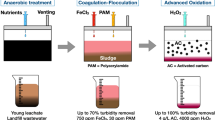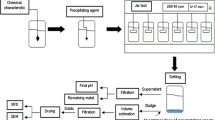Abstract
The biooxidation of sulfide under denitrifying conditions is a key process in the control of souring in oil reservoirs and in the treatment of gas and liquids contaminated with sulfide and nitrate. The effect of nitrate injection on the microbial community has been evaluated in the setting of offshore oil industry production, but has not been studied onshore, such as in the Algerian oilfields. A consortium of sulfate-reducing bacteria (SRB) was isolated by first inoculating saline Postgate’s medium C with injection water obtained from the In Amenas oil field, situated in the South Eastern Algerian Sahara, and then exposing the test solution to sulfate. When nitrate was dosed at 120 mg/l it was reduced by this bacterial consortium, with some ammonium production. This mechanism could be important in oilfield systems where nitrate is applied to prevent sulfide generation by SRB that leads to reservoir souring. In static tests, the influence of this SRB consortium on corrosion was assessed using carbon steel coupons, in the presence of sulfate alone and sulfate with 120 mg/l nitrate. The results of the static test indicate that the occurrence of pitting corrosion was fairly low under this condition. This is the first report on the use of nitrates in the fight against corrosion in the Algerian oil industry.






Similar content being viewed by others
References
American Public Health Association (APHA) (2005) Standard methods for the examination of water and wastewater. 21. Washington D.C., APHA
Beech IB, Sunner J (2004) Biocorrosion: towards understanding interactions between biofilms and metals. Curr Opin Biotechnol 15:81–186
Dalsgaard T, Bak F (1994) Nitrate reduction in sulfate-reducing bacterium, Desulfovibrio desulfuricans, isolated from a rice paddy soil: sulfide inhibition, kinetics and regulation. Appl Environ Microbiol 291–297
Davidova I, Hicks MS, Fedorak PM, SuXita JM (2001) The influence of nitrate on microbial processes in oil industry production waters. J Ind Microbiol Biotechnol 27:80–86
Dunsmore BC, Whitfield TB, Lawson PA, Collins MD (2004) Corrosion by sulfate reducing bacteria that utilize nitrate. Paper No. 04763 presented at CORROSION 2004. NACE International, Houston
Dzierzewicz Z, Cwalina B, Gawlik B, Wilczok T, Gonciarz Z (1997) Isolation and evaluation of susceptibility to sulphasalazine of Desulfovibrio desulfuricans strains from the human digestive tract. Acta Microbiol Pol 46:175–187
Eckford RE, Fedorack PM (2002) Planktonic nitrate-reducing bacteria and sulfate-reducing bacteria in some western Canadian oil field waters. J Ind Microbiol Biotechnol 29:83–92
Hitzman DO, Sperl GT (1994) A new microbial technology for enhanced oil recovery and sulfide prevention and reduction. SPE paper no. 27752. In: 9th Symp Improved Oil Recovery. Society of Petroleum Engineers, Richardson, pp 171–179
Hubert C, Voordouw G (2007) Oil field souring control by nitrate-reducing Sulfurospirillum spp. that outcompete sulfate-reducing bacteria for organic electron donors. Appl Environ Microbiol 73:2644–2652
Hubert C, Nemati M, Jenneman GE, Voordouw G (2003) Containment of biogenic sulfide production in continuous up-flow packed-bed bioreactors with nitrate or nitrite. Biotechnol Prog 19:338–345
Hubert C, Nemati M, Jenneman G, Voordouw G (2005) Corrosion risk associated with microbial souring control using nitrate or nitrite. Appl Microbiol Biotechnol 68:272–282
Jenneman GE, McInerney MJ, Knapp RM (1986) Effect of nitrate on biogenic sulfide production. Appl Environ Microbiol 51:1205–1211
Kjellerup BV, Veeh RH, Sumithraratne P, Thomsen TR, Buckingham-Meyer K, Frolund B, Sturman P (2005) Monitoring of microbial souring in chemically treated, produced-water biofilm systems using molecular techniques. J Ind Microbiol Biotechnol 32:163–170
Klein M, Friedrich M, Roger AJ, Hugenholtz P, Fishbain S, Abicht H, Blackall LL, Stahl DA, Wagner M (2001) Multiple lateral transfers of dissimilatory sulfite reductase genes between major lineages of sulfate-reducing prokaryotes. J Bacteriol 183:6028–6035
Larsen J (2002) Downhole nitrate applications to control sulfate-reducing bacteria activity and reservoir souring. Paper No. 02025 presented at Corrosion 2002. NACE International, Houston
Londry K, SuXita J (1999) Use of nitrate to control sulfide generation by sulfate-reducing bacteria associated with oily waste. J Ind Microbiol Biotechnol 22:582–589
Lovley DR, Chapelle FH (1995) Deep subsurface microbial processes. Rev Geophys 33:365–381
Madigan M, Martinko J, Parker J (2000) Biology of microorganisms, 9th edn. Prentice Hall, Upper Saddle River
Magot M, Ollivier B, Patel BKC (2000) Microbiology of petroleum reservoirs. Antonie Leeuwenhoek 77:103–116
McCready RGL, Gould WD, Cook FD (1983) Respiratory Nitrate Reduction by Desulfovibrio. Arch Microbiol 135:182–185
McInerney MJ, Bhupathiraju VK, Sublette KL (1992) Evaluation of microbial method to reduce hydrogen sulfide levels in a porous rock biofilm. J Ind Microbiol 11:53–58
McInerney MJ, Wofford NQ, Sublette KL (1996) Microbial control of hydrogen sulfide production in a porous medium. Appl Biochem Biotechnol 57/ 58:933–944
Myhr S, Lillebo BL, Sunde E, Beeder J, Torsvik T (2002) Inhibition of microbial H2S production in an oil reservoir model column by nitrate injection. Appl Microbiol Biotechnol 58:400–408
Nemati M, Jenneman GE, Voordouw G (2001) Mechanistic study of microbial control of hydrogen sulfide production in oil reservoirs. Biotechnol Bioeng 74:424–434
Postgate JR (1984) The sulfate-reducing bacteria. Cambridge University Press, Cambridge
Reinsel MA, Sears JT, Stewart PS, McInerney MJ (1996) Control of microbial souring by nitrate, nitrite or glutaraldehyde injection in a sandstone column. J Ind Microbiol 17:128–136
Smith RL (1997) Determining the terminal electron-accepting reaction in the saturated subsurface. In: Hurst HJ, Knudsen GR, McInerney MJ, Swetzenbach LD, Walter MV (eds) Manual of environmental microbiology. ASM Press, Washington D.C., pp 577–585
Stetter KO, Huber R, Blöchl E, Kurr M, Eden RD, Fielder M, Cash H, Vance H (1993) Hyperthemophilic archea are thriving in the deep North Sea and Alaskan oil reservoirs. Nature 365:743–745
Sublette KL, McInerney MJ, Montgomery AD, Bhupathiraju V (1994) Microbial oxidation of sulfides by Thiobacillus denitrificans for treatment of sour water and sour gases. In: Alpers NC, Blowes DW (eds) Environmental geochemistry of sulfide oxidation. American Chemical Society, Washington D.C., pp 68–78
Telang AJ, Jenneman GE, Voordouw G (1999) Sulfur cycling in mixed cultures of sulfide-oxidizing and sulfate- or sulfur- reducing oil field bacteria. Can J Microbiol 45:905–913
Thorstenson T, Bodtker G, Sunde E, Beeder J (2002) Biocide replacement by nitrate in sea water injection systems. Paper No. 02033 presented at Corrosion 2002. NACE International, Houston
Voordouw G, Armstrong SM, Reimer MF, Fouts B, Telang AJ, Shen Y, Gevertz D (1996) Characterization of 16 S rRNA genes from oil field microbial communities indicates the presence of a variety of sulfate reducing, fermentative, and sulfide-oxidizing bacteria. Appl Environ Microbiol 62:1623–1629
Zhu XY, Modi H, Kilbane JJ II (2006) Efficacy and risks of nitrate application for the mitigation of SRB-induced corrosion. Paper No. 06524 presented at CORROSION 2006. NACE International, Houston
Acknowledgments
This work was supported with the assistance of the Sonatrach Center for Research and Development and a scientific cooperation agreement with the Algerian Ministry of Education.
Author information
Authors and Affiliations
Corresponding author
Rights and permissions
About this article
Cite this article
Kebbouche-Gana, S., Gana, M.L. Biocorrosion of carbon steel by a nitrate-utilizing consortium of sulfate-reducing bacteria obtained from an Algerian oil field. Ann Microbiol 62, 203–210 (2012). https://doi.org/10.1007/s13213-011-0247-0
Received:
Accepted:
Published:
Issue Date:
DOI: https://doi.org/10.1007/s13213-011-0247-0




